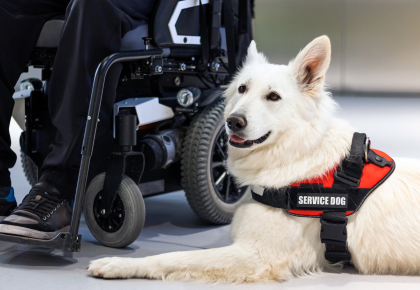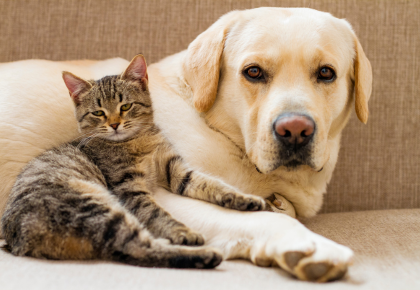Setting reasonable pet policies for your condominium: What you need to know
 According to a recent study conducted by the Canadian Animal Health Institute, approximately 60% of Canadian households own a pet. So, it’s very likely that your condominium community is home to some furry residents as well.
According to a recent study conducted by the Canadian Animal Health Institute, approximately 60% of Canadian households own a pet. So, it’s very likely that your condominium community is home to some furry residents as well.
When your community is pet-friendly, it’s important for the board to determine the best way to maintain order and keep pets from becoming a nuisance to neighbours and the condominium at large.
So how can you board create reasonable pet policies without causing strife in the community? Read on as we share what you need to consider when doing so.
Understand the difference between a pet and a service animal
 Ahead of making rules around pets, it’s important to understand the difference between a pet and a service animal. For the purposes of creating rules for your community, pets are defined as companion animals. Pets can provide emotional benefits to their owners, such as reducing stress or easing loneliness.
Ahead of making rules around pets, it’s important to understand the difference between a pet and a service animal. For the purposes of creating rules for your community, pets are defined as companion animals. Pets can provide emotional benefits to their owners, such as reducing stress or easing loneliness.
Service animals are working animals that assist people with disabilities and are not considered pets. In Alberta, The Service Dogs Act provides those with disabilities, who use qualified service dogs, the right of access to public places and those with service dogs cannot be denied occupancy of any self-contained dwelling unit. Those that require a service animal will have an identification card where both the person and that person’s service dog are identified.
Condominium pet policies need to be reasonable
As tempting as an outright ban on pets can sound to some, pet-friendly communities are a selling point for many potential residents. To keep issues to a minimum, solid condominium pet policies will go a long way. However, the rules need to have a purpose that is easy to define and are easy for residents to follow. Before setting any new pet rules, or revising existing ones, it’s important to discuss with your legal counsel. They know the ins and outs of any local laws that may need to be considered and can help make sure your rules are written in such a way that residents can’t find loopholes.
Common rules found within condominium communities include rules about animal types, breeds, weight restrictions, pet use of common areas, and where leashes must be used. When considering implementing these types of rules it’s important to consider how easy they are to enforce.
For example, weight restrictions are often popular to keep larger animals out of the community. However, rules specific to an animal’s weight can be hard to enforce. To ensure the rule is being followed, who is weighing all the pets in the community? What happens when a dog gains a few pounds from too many treats and ends up over the weight limit?
As you can see, setting weight limits is not the best way to go about keeping large animal breeds from moving in. In the event your board wants a rule about the specific types of animals and breeds that are allowed in the community, it’s easier to list what is and isn’t allowed. If you choose to set a rule about specific breeds, you should work closely with your attorney to craft it to ensure you aren’t setting something unrealistic.
An example of a common rule that every community could put in place would be to state that an animal’s owner must clean any waste deposited in common areas, and refusal to do so would result in a fine. To make this rule easier for residents to follow, you could consider placing dog waste disposal units that include a bag dispenser in the common outdoor areas that pets are allowed to use.
Not only does a rule like this show that your board is dedicated to keeping community grounds clean, but the addition of a pet amenity goes a long way in showing you consider pets a valuable part of your community.
Rules may differ for renters
It’s important to note that if you have units in your community that are rented out by owners, they can implement their own rules regarding pets. These rules should fall in line with the rules the board has set for the community, but they can add additional rules. For example, they can decide they don’t want to allow pets in their unit. For this reason, within your communication you should mention that tenants that rent from an owner need to follow the rules set by their landlord in addition to the community rules.
Communication is key for compliance
You can’t expect residents to follow the rules if they don’t know what they are. That’s why new or updated pet rules need to be communicated to residents on a regular basis. That can be done through signage around the building, emails, or community newsletters.
 When introducing a new rule, be clear with the purpose. A resident is more likely to follow the rule if they understand it’s been put in place to protect them in terms of their comfort, health, and overall safety.
When introducing a new rule, be clear with the purpose. A resident is more likely to follow the rule if they understand it’s been put in place to protect them in terms of their comfort, health, and overall safety.
Another way to increase compliance is through clear communication of the consequences a resident will face should they not follow the rules. If as a board you decide to impose fines for rules being broken, let the residents know what those fines are. People are more inclined to clean up after their pet versus paying a monetary fine for not doing so.
Ahead of setting fines and determining the process for rule enforcement, you should work with your legal counsel to ensure your enforcement procedure and fines are reasonable.
Exceptions can be made sparingly
There are some cases where exceptions can be made for pet rules. Should your community be a strict no pets community, service dogs would be an exception to that rule. As mentioned earlier, The Service Dogs Act protects the rights of those with disabilities that require a qualified service animal. Therefore, in these cases, the condominium board should work with its legal counsel to ensure reasonable accommodations of approved service animals.
Another example of where exceptions can be made, is if after too many issues with pets, your community decides to institute a new no-pets rule, but some residents already have pets. In this case, there is the option to “grandfather” current pets in, allowing the animal to remain with its family, and no one is forced from their homes. With this option, the updated rule must be well communicated to any new residents to avoid misunderstandings of exceptions to the rule.
Lean on your legal counsel and property management team
Like with the creation of any rules for your condominium, there is a lot to consider when it comes to pet policies. However, because this is about resident’s furry family members, it’s often more complex and can be a sensitive issue for community members. That’s why it’s so important to work closely with your legal counsel when drafting the rules. They will help you create sensible rules that can be enforced, setting your community up for success.
And when it comes to communicating and enforcing the rules, it’s important you lean on the expertise of your property management team. They have the experience and tools to make communicating and enforcing the rules a breeze. Because reasonable pet policies can go a long way in keeping your human and four-legged residents happy.